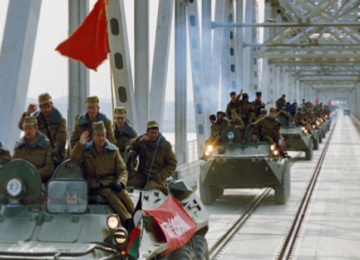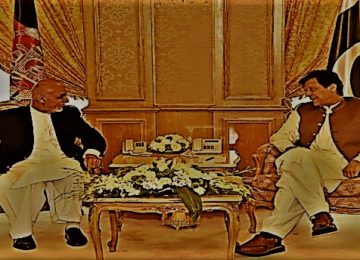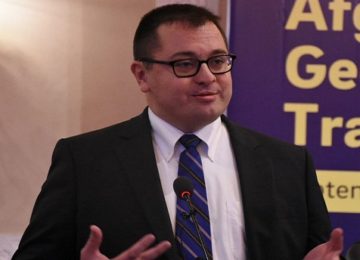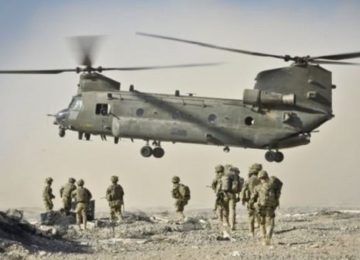July 24, 2019
Representatives of Afghanistan’s warring parties and civil society met at a peace conference in Qatar’s capital Doha on 7-8 July 2019. They all participated ‘in their personal capacities’ in order to circumvent the Taliban’s rejection of direct talks with the Afghan government. The conference that took place behind closed doors ended with a joint final resolution.
At the end of the two-day conference that was initially dubbed an “Intra-Afghan Dialogue” but was renamed the “Intra-Afghan Peace Conference” by the participants, gifts were distributed. They came from Mullah Baradar, the Taliban deputy chief for political affairs. Parwiz Shamal, news chief for the Afghan TV channel Tolonews (his boss, Lotfullah Najafizada was among the participants), posted photos showing participants with gift bags from a Qatari shopping centre, containing dates and perfume for the male participants, and additionally headscarves and prayer mats for the women.
The gifts were not without meaning. Female participants from Kabul told a reporter that they had asked Taliban members in a lobby encounter during the conference whether their way of doing the hijab (Islamic cover), wearing the chadri (headscarf) and not a burqa, was sufficient for them. They were told it was, and, through the gifts, received another affirmative answer.
Who participated in the conference?
The conference brought together representatives from the Afghan government, opposition politicians, media and civil society activists with the Taliban. All were invited ‘in their personal capacities’, as the Taliban do not recognise the government and officially refuse to talk to it. The list of participants was not officially released in advance but soon found its way into social media.
The list included 62 Afghans. Of these, 17 were Taliban members, the others came together from Kabul on board of a plane charted by the German government. 11 of the representatives were women but none of them from the Taliban’s side (a full participants list is included in the annex)
In the run-up to the conference, it was agreed that no acting Afghan ministers, former (very) high office holders or candidates for the September 2019 presidential election would be invited. This thus excluded Hanif Atmar, Dr Abdullah, Yunos Qanuni, Gulbuddin Hekmatyar, Zalmay Rassul; ex-President Hamed Karzai; and, of course, current President Ashraf Ghani himself. Organisers made it clear that they wanted to keep the meeting out of the election campaign. The Taliban reciprocated by not sending Baradar.
This was different from earlier meetings held in Moscow in February and May 2019, where several presidential candidates and also Baradar participated . There, Afghan government representatives were either not invited, or chose not to participate as they were not invited ‘as the government.
Among the highest-ranking government delegates were a woman, former civil society activist Shaharzad Akbar, now deputy head of the National Security Council; Ahmad Nader Naderi, head of the Civil Service Reform Commission and former human rights commissioner; and Abdul Matin Bek, head of the Independent Directorate for Local Governance. All three, as well as others, represented the new generation of modern educated politicians. The deputy chairman of Afghanistan’s High Peace Council (HPC), Attaullah Rahman Salim, was also in attendance. The HPC, a body that is formally independent but appointed by the president, is not seen by the Taleban as impartial.
Some participants from Kabul represented their fathers’ generation of military leaders from the civil war: Matin Bek, son of the assassinated northeastern Afghan mujahedin commander Mutaleb Bek; Bator Dostum, son of Jombesh party leader Abdul Rashid Dostum; and Khaled Nur, son of former Balkh governor Atta Muhammad Nur. With Ghairat Bahir and Mohiuddin Mehdi, Hezb-e Islami and Jamiat-e Islami were also present, as were other former mujahedin and other armed group leaders such as Sayed Hamed Gailani, Haji Din Muhammad and Sayed Mansur Naderi from one of the country’s two divided Ismaili communities whose home region, the Kayan valley in Baghlan, has just been taken over by Taliban. For the ‘reconciled’ Taliban, Mullah Abdul Salam Zaif came from Kabul.
From among civil society and media activists, there was Mary Akrami, executive director of the Afghan Women’s Network; Seddiqullah Tawhidi, Executive Director of Afghan Journalists Safety Committee and Hadi Marefat from the Afghanistan Human Rights and Democracy Organisation, which runs a museum and research institute on the victims of the past 40 years of the Afghan war.
The highest-ranking Talib was Mullah Sher Muhammad Abbas, the head of their political office in Doha that doubles as the movement’s negotiations team in parallel negotiations with the US . There were also the five former Guantanamo inmates released in a prisoner exchange in 2014. Baradar, whose original name is Mullah Abdul Ghani, did not personally participate in this meeting, however, he was in Doha for the seventh round of negotiations with US chief envoy Zalmay Khalilzad. Those negotiations were paused to enable the two-day dialogue meeting to take place.
Apart from Akbar and Akrami, among the female participants were Habiba Sarabi, former women’s affairs minister and the first Afghan woman who was governor of a province (Bamyan, from 2005 to 2013); former MPs Fawzia Kufi who had also been at the Moscow meetings and Shahgul Rezayi, a Hazara from Ghazni; as well as Anarkali Kaur Honaryar, a medical doctor and representative of the small Afghan Sikh community (often also representing the Hindus, by default) and another former MP. Honaryar spoke prominently on the first day and made an even deeper impression on the second, when she single-handedly initiated the adding of a clause about the need to “respect and protect” religious and ethnic minorities in the resolution.
Who organised the conference?
The conference was jointly prepared by the host country, Qatar, and Germany. Qatar is already the host for the ongoing US-Taleban negotiations as well as being the seat of the Taliban’s political office. Germany had already helped in getting a first round of US-Taliban negotiations underway in 2010. Those talks culminated in the 2014 prisoner exchange and the establishment of the Taleban’s office in Qatar, but petered out in a dispute over the Taliban office’s status.
A first attempt to bring the Taliban and Afghans from Kabul together in Qatar in April earlier this year failed. It had been organised by the Center for Conflict and Humanitarian Studies (CCHS) in Doha that had been commissioned for that purpose by Qatar’s government. Following this failure, the Germans, in agreement with the US, brought in a six-person team from the Berghof Foundation, a non-governmental body with experience in conflict mediation in Sudan and the Horn of Africa.
On the eve of the conference, lunch and dinner meetings were organised to “break the ice,” as CCHS director Sultan Barakat tweeted. At least one of these meetings was also attended by Khalilzad. With his participation, he signalled that the conference had the US’s consent. US Secretary of State Mike Pompeo had stated during a Kabul visit on 25 June 2019 that the German-Qatari initiative had helped “laying the groundwork for inter-Afghan negotiations to begin as soon as possible.” The US considers such negotiations as one of the four main topics of a future peace agreement with the Taleban.
The Qatari and German governments’ special representatives for Afghanistan, Mutlaq al-Qahtani and Markus Potzel, opened the conference with short statements and then left the room, while the Berghof team remained for assistance.
What was the outcome of the conference?
The organisers did not provide an agenda; rather they left it to the participants to develop one. They came up with one which reflected the organisers’ and mediators’ intention that there should be less of a series of statements on the various positions and more focus on the methodology of future negotiations. The session headlines were: “objectives and principles”, “topics and issues” and “next step” (in singular).
At the end of the two days, the participants published a two-page joint “Resolution of Intra Afghan Peace Conference.” Its Pashto and Farsi/Dari versions (which had some inconsistencies between them) were read in the plenum, the former by ex-Taliban minister and leadership council member Amir Khan Mutaqi, the latter by Habiba Sarabi. The documents (see the full text in the annex) contain a number of joint positions but also display a number of blanks.
Following the obligatory thanks to the organisers, participants began with calling for “dialogue and agreement (…) to reach an understanding concerning our present and future.” This should be done through what is called, somewhat clumsily, “Afghan all-inclusive negotiations” (muzakerat-e hama-shumul-e Afghani). This part of the resolution caters to the worries of the Afghan government that felt excluded from the earlier dialogue meetings in Moscow and still is excluded from US-Taliban negotiations, but only partly, as it does not reflect the government’s position that it needs to be present ‘as the government’ and not only as one among many Afghan parties. Of course, the government’s status in future negotiations also depends on whether such negotiations begin before or after the planned September 2019 election.
The resolution then urges all parties to reduce violence, not to attack public institutions and to bring civilian casualties “to zero.” It appeals to “ensure the security (…) of schools, madrassas, hospitals, markets, dams and other workplaces.” Furthermore, all parties are “encouraged” to release “elderly, incapacitated and ill prisoners” and to stop calling each other names, in order to “not fuel the conflict and revenge.” This refers to the Taliban labelling the Afghan government ‘US marionettes’ void of any decision-making power of its own, while many parties in Afghanistan call them ‘terrorists’ and ‘tools of foreign interests’, mainly of Pakistan.
In a separate paragraph, educational institutions (“schools, universities, and other educational institutions”) were listed together with residential areas to be “respected.” This reflects concerns on all sides. Private education centres have been attacked by insurgents (though mainly by the local Daesh outfit, the Islamic State Khorasan Province, see an example from Kabul in 2018 here), while madrassas in Taliban-controlled areas have also been targeted by airstrikes.
Among the inconsistencies between the various versions of the documents are that the Farsi/Dari version specifies that only “civilian” (mulki) educational facilities should not be attacked. This leaves the way open for continued attacks on military and police training centres. One Afghan commentator on social media asked why, despite the resolution’s long list, other types of institution that have been targets of attacks in the past had been left out or had threats hanging over them: “What about sports facilities? Journalists? Vehicles carrying civil servants? Non-security sector ministries?” The clause about the protection of civilians is further limited – again in its Dari version – by the caveat, this should be “attempted.”
Although all participants came as ‘in their personal capacity’, it is clear that they spoke on behalf of their respective organisations or institutions. However, and despite envoy Potzel’s statement that the resolution’s content constituted both an “appeal and promise,” it remains a document that is not binding. The resolution represents no agreement or pact. Taliban chief negotiator Stanakzai also emphasised this point immediately after the conference. He said, “These decisions are implementable when an intra-Afghan dialogue is held and the governance, women rights, education and other issues are discussed.”
However, the resolution can now be publicly referred to if parties to the conflict violate any of the included declarations of intent. Furthermore, all parties already insist that they are protecting civilians and civilian institutions while, in practice, regularly violating this . A commentary by International Crisis Group’s Borhan Osman published on 5 July 2019 showed how this affects lives and traumatises many, mainly in rural Afghanistan.
Parties found it easier to agree on some other principles such as that Afghanistan should have an “Islamic order” (this is already a provision in the current constitution); “necessary reform, preservation and strengthening” of state, including defence-related institutions (President Ghani has even offered even constitutional changes, the dignified return and resettlement of refugees and IDPs; to request neighbouring and regional countries to cease all interference in Afghanistan’s affairs or to work out new conditions for future donor assistance (the English version only has an appeal for new assistance).
The same goes for some aspects of a future “peace agreement,” namely that it should be (externally?) monitored and observed, and that there should be another international conference to work out guarantees for the implementation of this agreement.
It is also interesting to note what the resolution does not contain. There is no mention of a ceasefire. This is the biggest wish of many people in Afghanistan who suffer from the daily threats and actions of war, and several participants brought this up in the plenary sessions. There is also no mention of the withdrawal of foreign forces, on the need of which all sides agree, although under different circumstances. Government representative Nader Naderi stated from Doha that the Taliban objected to calling for a “responsible” withdrawal; it seems that in their eyes this could open a backdoor for an extension of the presence of at least some foreign troops or an ‘anti-terrorism’ intelligence component, as President Donald Trump has publicly favoured.
Similarly, Afghanistan’s existing international commitments are not mentioned because of, according to Naderi, Taliban reservations. This has been interpreted as a Taliban rejection of women’s rights (which are alluded to as “within the framework of Islamic values”). A news agency quoted delegates as saying that the Taliban officials were welcoming in general although less willing to discuss issues such as women’s rights and freedoms in society.
Some commentators have started to call the resolution a ‘road-map’. Participant Mary Akrami is more cautious. She said, “It’s not an agreement, it’s a foundation to start the discussion.”
The intra-Afghan meetings are supposed to be continued. German envoy Potzel told Tolo TV this could happen “in Uzbekistan or Europe.” Norway has been mentioned, also Indonesia. Potzel was reluctant to say whether Germany would continue to help organise such a follow-up meeting. He added his government hoped “that this dialogue format will mark the starting point for a comprehensive peace process in Afghanistan.”
What is the link to the parallel US-Taliban talks in Doha?
On the US-Taliban talks in Doha, there has recently been contradictory news. On the one hand, in a press briefing in Doha on the day the conference started, Khalilzad said there had been “substantive” progress in his negotiations with the Taliban on all four issues key to a peace agreement and that his discussions had broadened to include a timeline for both intra-Afghan negotiations as well as a cease-fire. On the other hand, the Taliban denied this was the case. They insist that only the foreign troop withdrawal and anti-terrorism guarantees were discussed in these negotiations, not the involvement of the Afghan government, as desired by Kabul and supported by Washington, or a ceasefire.
Khalilzad further said he hoped that the Doha conference would produce a “political roadmap” for the intra-Afghan negotiations about Afghanistan’s post-agreement future and echoed Pompeo’s Kabul statement that Washington’s “aspiration” was to have that framework in place by 1 September, still before the scheduled Afghan presidential election. However, he also indicated that he expects that the full agreement would need longer when he said that it would ultimately be up to Afghans to decide among themselves the agenda for negotiations, as well as the terms of a cease-fire.
This desired link between the US-Taliban negotiations and the now begun intra-Afghan dialogue that still needs to morph into intra-Afghan negotiations, still has to emerge. The joint resolution from the Doha conference, did not, at the very least, create new obstacles. The paragraph that a peace process should start “simultaneously with the accomplishment of all terms and conditions set forth” seems to refer to the Taliban’s insistence that there be a publicized and internationally witnessed timetable for the withdrawal of foreign troops before the internal aspects of Afghanistan’s post-agreement political set-up can be discussed, ie in the intra-Afghan negotiations. But it can also be read as an affirmation of the US principle, not shared by the Taliban, that “nothing is agreed until everything is agreed.”
In the meantime, the US-Taliban talks in Doha resumed and reportedly concluded on 9 July. Results are still unknown. Reuters quoted a senior US official “privy to the talks” that “Khalilzad will now brief his bosses and they will make an announcement. The seventh round has ended.”
What were the reactions to the conference in Afghanistan?
Habiba Sarabi, one of the highest-ranking participants at the conference called it “successful.”Naderi was quoted as saying that “Many differences were made clear in the two days [of the meeting], meanwhile, common points were recognized. These common points will provide the ground for more trust and [direct] talks between the Afghan government and the Taliban for ending the war.”
President Ghani, who has not issued a statement about the conference so far, only reacted indirectly. Again without mentioning the conference, he was quoted as saying at an anti-corruption conference in Kabul on 10 July 2019 that talks should take place between the government and the Taliban, because they are the two parties at war. The Afghan foreign ministry, meanwhile, welcomed the final declaration from Doha, saying that time is short and there was a need for the launch of an intra-Afghan dialogue to reach a peace deal.
Not everyone in Afghanistan supported the delegation from Kabul going to Doha and talking with the Taliban, particularly after the Taliban’s heavy car bomb attack in Kabul on 1 July 2019 against a ministry of defence installation, that wounded more than one hundred civilians, many of them school children. Following this latest attack, the government’s Chief Executive, Dr Abdullah, called the Taliban “a group with an inherent criminal nature.” There were calls for a boycott or at least “holding off” the meeting.
After the conference, the same critics questioned whether the conference’s outcome represented any progress. Wazhma Frogh, a prominent women’s rights activist, stated that it was “naïve & dangerous” when participants believed the Taliban had changed at least some positions.
The critics have good and often very personal reasons to oppose the Taliban and doubt their intentions. Too often the Taliban’s words and deeds are contradictory, as the many civilian casualties in attacks that targeted military installations showed. But neither have critics shown any realistic alternative on how to end the 40-year war – which is the most bloody worldwide – without talking and compromising with the Taliban.
There is also a sense of denial that the current state of affairs in Afghanistan cannot solely be blamed on the Taliban (and Pakistan) but that there are also massive faults within the current system. Afghanistan’s so-called unity government, with Ghani and Abdullah at its helm, despite many big words, has not managed to develop a convincing negotiations strategy or put it to a broad national consensus. Those intervening from outside have – often all but in words – turned a blind eye to corruption within the government and widespread torture used in the security forces it has supported, with that playing into the hands of the Taliban. Segments of Afghanistan’s elites, including of civil society, turn a blind eye when half of the population lives in poverty and civilians in Taliban-controlled areas are killed on an almost daily basis by the army they support. Refusing to negotiate and denying them a place in Afghanistan’s future is the recipe for sustained war and killing.
What does it all mean?
That the Doha conference participants managed to draw up a joint final declaration was more than many had expected. After 40 years of war and the killing of almost 230,000 people after 1989, it is a success when something moves forward, if even by only a small step. And although this was not – as variously reported – the first time that Taliban and government representatives have sat and talked in one room (there were earlier meetings, organised in France and Japan in 2012, declared as academic conferences, and track II meeting, such as the ones organised by Pugwash in Norway, the Taliban met female Afghan politicians for the first time in 2015, it is a new beginning in the search for a negotiated end to the war in Afghanistan.
The final resolution includes a relatively long list of joint positions by the warring parties as well as other participants but many of those are relatively general and were easy to agree on. Large gaps remain, however, from political and women’s rights to the sequencing of a peace agreement – in addition to the skepticism felt by large parts of the Afghan public and political classes. But this can also be seen as a positive point, insofar as the gaps became visible. This is what the parties and mediators can and have to work on. But it is too early to call the Doha outcome a fully workable ‘road map’; only one has visible contours for the time being.
The Doha Intra-Afghan Peace Conference was likely just the first in what has to become a series of meetings, during which the process has to morph from conferences to fully-fledged intra-Afghan negotiations. There will undoubtedly be a lot of stumbling blocks lying in the details that still need to be worked out on a whole range of problems, from where a future government’s legitimacy will come (through elections and if so, in what form of elections?) to disarmament and the costly reintegration of decommissioned fighters. The calls to protect civilians and civilian institutions that answer to widespread popular feelings could also be turned on its head. When all parties start accusing one another of not heeding these calls, this could undermine the little trust already created and reflected in the joint resolution before intra-Afghan negotiations have even begun. (3)
Importantly, both the Taliban and the Afghan government have moved forwards. This has paved the way for direct talks between them becoming a possibility – the Taliban by sitting with government representatives, Kabul by not putting obstacles in the way of the Doha conference and by not insisting that their representatives appear in their official capacities. But, as previously mentioned, the devil will be in the detail.
By Special Arrangement with AAN. Original link.
Disclaimer: Views expressed on this blog are not necessarily endorsed or supported by the Afghan Studies Center and Center for Research and Security Studies, Islamabad.








